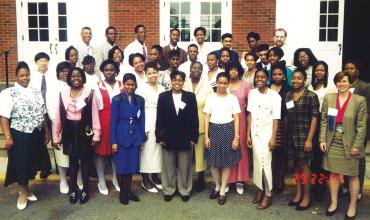My passion for politics has been lifelong, but the art and science of turning that passion into student engagement was kindled in the classrooms of Clara Barton High School, where I learned how to teach civics education. While serving as legal counsel for New York City’s United Federation of Teachers in the late 1980s, I had worked closely with Clara Barton, helping it through a health and safety crisis caused by construction work that had been improperly conducted on asbestos-containing insulation, ceilings, walls, and floor tiles. The relationships that were formed in that work led to an invitation to teach in the school, and I joined its faculty as a social studies teacher in September 1991.
More than a quarter of a century later, I can still vividly recall my excitement and anticipation—and my nervousness—the day I first stood in front of a political science class at Clara Barton. My students were intellectually curious, thoughtful, and hard working. As students of color, mostly of African descent, and with many first-generation immigrants from the Caribbean among their number, they brought a rich set of real-world experiences to the study of politics and government. The challenge for me as a new teacher was how to actively engage them in their learning so that their great potential could be fully realized.
Clara Barton had a solid cohort of experienced and accomplished educators, and I drew upon their professional expertise and advice as I developed my own pedagogical approach. They helped me more than I can ever properly thank them, in particular Leo Casey, with whom I taught several Advanced Placement (AP) United States Government and Politics classes. I had practiced law and litigated cases—in courts and in arbitration forums. I knew that the practice of law was more important than the study of law. Likewise, I had studied John Dewey’s educational philosophy and believed in his focus on learning by doing, but I did not appreciate the full power of this approach until I saw how Barton teachers used it, and I began applying it in my own teaching.
For instance, one of my classes took part in the We the People civics competition on the Constitution and Bill of Rights. Students participated in mock congressional hearings and debates to demonstrate their ability to apply their knowledge and understanding of American government to contemporary issues. Since this was shortly after the first Gulf War, students debated the war-making powers of Congress and the president. And, at a time when the Supreme Court had upheld laws criminalizing gay sexuality, they analyzed the rights of all Americans to privacy and intimacy. They spoke eloquently on the First Amendment protections of their speech in the schoolhouse, on how the principles of the Fourteenth Amendment should be applied to affirmative action programs, on what the Fourth Amendment had to say about police stopping and searching them on the street, and on whether the United States still needed a strong Voting Rights Act. And they related these questions to the very principles underlying American government—natural rights philosophy, republicanism, and the Lockean social contract.
In sum, my students learned how to be democratic citizens by actively using civic knowledge and practicing the skills of citizenship. Empowered by this method of education and its relevancy to their lives, they were motivated to give this work their all and went on to defeat schools from much more advantaged settings, winning the New York state championship and placing fourth in the nation in the We the People competition.
During my years at Clara Barton, I went on to teach courses in law, American history, and ethical issues in medicine, and I applied the insights I had acquired on how to actively engage students in their learning. My law class was centered on a mock trial, in which students acted out the different roles of judge, jury, prosecution, and defense. In my ethical issues in medicine class, our practical nursing students debated real-life challenges and dilemmas in healthcare, and, weighing values such as respect for life and respect for patient autonomy, discussed how they should be handled. In my history class, students engaged in a project of researching candidates for elected office and volunteering on the campaign of the candidate of their choice.
What I learned from my teaching is that engagement is essential. Student engagement and knowledge lead to critical thinking, confidence, judgment, and empowerment. While I am a teacher of social studies and civics, and my approach is rooted in my experience, the same practices of active student engagement—project-based instruction, student inquiry, and experiential learning—are no less applicable in other subjects. But I believe these practices hold a special value and importance for civics education today: the future of our republic and democratic governance hangs in the balance at this critical moment, and active democratic citizenship is essential for its survival. Civics education, in which students learn democratic citizenship by practicing it, is essential not just for good education, but for democracy itself.

